| Nazca | Pisco | Lima |
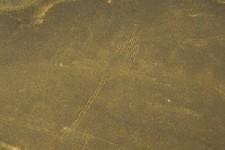
I think airlines should take some design tips from Peru's overnight buses, the seats recline further and are much more comfortable than airlines seats. Most travellers find the touts that greet you at train stations and bus stations annoying but personal I find them useful. For only a couple of bucks they will find you a hotel, book excursions for you and drive you around. You just have to be a bit firm with them, otherwise you end up staying in their uncles expensive hostel and taking their brother's expensive tours. If you know what you want they are a good resource.
|
We were greeted at the bus station by several touts. Personal I could not be bothered to walk around town looking for a place to stay and then find agencies to do some sightseeing. I just made eye contact with one of the older touts who had access to a car. We stopped at several hotels until we found one we liked then we told the tout that we wanted a flightseeing tour over the Nazca lines and an afternoon tour of the cemetery of Chauchilla. He made the arrangements after telling us don't get breakfast until after the flight. Most people come to Nazca to see the lines. In case you don't know what the Nazca lines are they are huge geometric designs drawn in the desert and only really visible from the air. Some lines represent animals while others are perfect triangles, rectangles or straight lines running for many kilometres. There are many theories to try to explain these lines. The German mathematician, Maria Reiche, has made it hers life work to study these lines and thinks they were made by the Paracas and Nazca cultures between 900 BC to 600 AD. She considers the lines an astronomical calendar for agricultural purposes. My favorite theory is that the Nazca built hot-air balloons to aid in construction, a thousand years before Europeans developed lighter than air aircrafts. For a very fanciful theory, Erich von Daniken thinks the lines are landing sites for aliens (insert X-files music). |
Although you can get an oblique view of three of the figures from an observation tower about 20 km north of town, the best way to view the lines is from the air. Flights are in light aircraft seating from three to nine people. Flights cost about US$50-55 and last 30-45 minutes. The flight can be very bumpy with many tight turns as the pilot gives people on both sides of the aircraft good views of the shapes on the ground. People do get airsick so don't have breakfast before your flight.
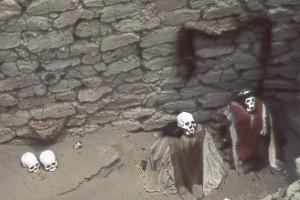
Many people come to Nazca, take a flight then head out of town, it is easily done. Nazca is unexceptional town, even the main church is unimpressive in a land full of colonial churches. But there are other sites to explore and you can also visit a potter's or goldsmith's shop for a demonstration and shopping.
The cemetery of Chauchilla is about 30 km away and tours can easily be organized in Nazca, you will probably be squeezed into a car with three or four other people. At the cemetery you will see bones, skulls, mummies, pottery shards and fragments of cloth. Grave robbers have long stolen anything of value but its quite amazing to stand in the desert and see bleached bones stretch off into the distance. Nearer to town is the Cantallo aqueducts, built by the Nazcas and still in working order.
Pisco is about a four hour bus ride from Nazca, make sure the bus actually stops in Pisco since the town site is about 5 km off the Pan-American Highway and many bus companies just drop passengers off at the turnoff.
Pisco shares its name with the white grape brandy produced in the region. A pisco sour is a commonly served drink in Peru. Although the town itself has some charm, the main reason people visit the town is to see the wildlife of the nearby Islas Ballestas and Península de Paracas.
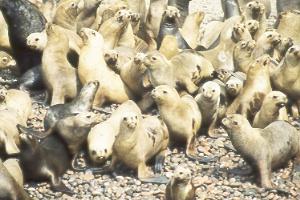
Islas Ballestas is sometimes called the poor man`s Galápagos, a half day tour will cost about 25 sols. The Guanay Cormorant and the Peruvian Booby are important birds that inhabit the islands and are great indication of the delicate balance of nature. These birds are very inefficient digestors of the fish they eat, mainly anchovies, and therefore the birds produce a very rich guano (bird droppings). Its a local industry to harvest the guano as fertilizers but it also enriches the waters of Peru creating the second riches fishing grounds in the world. In case you don't know the Grand Banks of Newfoundland is the world's richest fishing grounds. With the creation of artificial fertilizers the price for the guano dropped so many former guano harvesters turned to fishing. Intensive fishing meant there was less food for the seabirds to eat so the seabirds starved, millions washed up on the beaches which probably benefitted condor and other carrion eaters. One year 14 million tonnes of anchovies were harvested. Because there were fewer birds produced guano there was less nutrients entering the water therefore phytoplankton production collapsed. Because there was a decrease in phytoplankton there was less food for the anchovies so the fishery collapsed. This took about seven years. Peru is still a major fish harvesting nation but the yield of anchovies has never fully recovered and fluctuates greatly year to year.
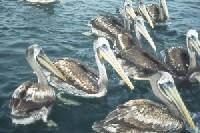
Don't mean to be so gloom and doom about the collapse of the natural world, you will see plenty of animals. Whatever tour company you booked with will pool their resources and you will probably be picked up at your hotel for the 15 km drive to Puerto Paracas. You will pass a huge fish meal plant along the way, if your lucky the wind will not be blowing toward you. There were several boats waiting for us, they had lifejackets for everyone. The tour boats shared the same pier with fisherman unloading their boats.
It takes between one and two hours to reach Islas Ballestas depending and both the boat and weather. Along the way you will see the Candelabra, a giant figure etched into the coastal hills similar to the Nazca lines.
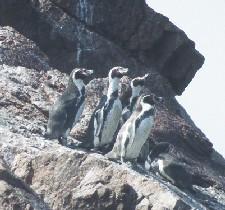
About an hour is spend cruising around the three islands. You will see the guano facilities on several of the islands. Guano is still harvested but more regulated than in the past. Each island is only harvested once every seven years and harvesting only occurs before nesting season. Along with the Guanay Cormorant and the Peruvian Booby I've already mentioned you will see plenty of sea lions which swim right up to the boat and pelicans. The islands are also home to penguins which our tour guide told as are delicious so the penguins often flee at the sound of motorboats. We were lucky and saw several of them. Wear a hat, not only because of the sun but to avoid a direct hit from guano producing seabirds.
A tour of the islands will take a half a day. If you have the time tours of the Península de Paracas can be combined with the Islas Ballestas tour for a full day excursion. This is a good experience, if for no other reason than to experience the coastal desert. The coastal desert starts in northern Peru and continues to Chile. In non El Niño years the desert might receive 2 millimetres of rain. Bring plenty of water. A tour of the Península de Paracas should include a visit to a flamingo colony, the small fishing village of Lagunillas where you can get good seafood, an impressive rock formation called the Cathedral, and a visit to the Museo JC Tello. At the museum you will learn about the archaeology of the Paracas area which predates the Inca by 1000 years. Although some of the better pieces have been stolen there are some artifacts including a couple of trepanned skulls and some skulls that show indications of successful brain surgery.
Lima is the capital of Peru with a third of the countries population. Its as ugly as Cuszo is beautiful. A coastal fog called garúa covers the city in fine gray mist for most of the year. It's a mostly ugly sprawl with some interesting colonial buildings and some of the best museums in the country. You can't avoid Lima since most international flights into or out of Peru pass through Lima. If you must stay overnight don't stay in Lima itself but in the nearby middle class suburb of Miraflores. You could spend days exploring all the museums of Lima, unfortunately they are spread out throughout the city and its suburbs so you be spending a lot of time in taxis.
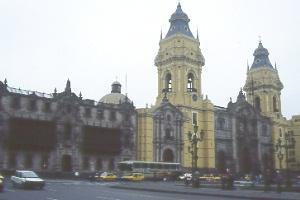
The Plaza de Armas in Lima was once the heart of Lima and contains the main cathedral, an exquisitely balconied Archbishop's palace, the presidential palace along with various shops, fountains and statues. The Plaza San Martín is connected to the Plaza de Armas by a pedestrian street Jirón de la Unión which contains several good stores. Also near the Plaza de Armas is the San Francisco church which is famous for its catacombs. This can easily be visited in half a day.
After lunch we planned on visiting some museums, of course the museums we wanted to visited we located in different suburbs in this sprawling city. A taxi ride will probably cost about 15 sols depending on distance. The first museum was Museo de la Nación (National Museum) which is located in San Borja. This museum offers the best overview of the nations archaeological heritage with excellent models of Peru's major ruins. A great opportunity to learn about what you never had the time to see. Tours are available in English.
The other museum we visited was Museo de Oro del Peru (Gold Museum) a private collection and probably the most visited museum in the city. We probably had the only taxi driver who did not know where the museum was located. First he took us to the wrong museum in the wrong suburb. He stopped several times to ask for directions, he even had to stop for gas. Two hours later we arrived and there were several large tour buses parked at the museum. This is really two museums with an expensive admission. The Gold museum is located in a basement vault and contains thousands of pieces from gold earplugs to ponchos made with hundreds of gold plates. I found the pottery collection more interesting, some of it was pornographic. The other museum is an Arms museum, not being much interested in guns I just breezed through. I wanted to see more of the pottery.
On our second Lima visit we decided to visit the Museo de Arte which is housed in the impressive former International Exhibition Palace. It is more than an art museum, there are also collections ranging from colonial furniture to pre-Columbian artifacts. The Exhibition grounds are also well tended and worth a stroll.
After lunch we decided to visit the Museo Nacional de Antropologia y Arquelogía which used to have the best prehistory collection in Peru but some of the best pieces have been moved to the National Museum but a worthwhile collection still remains. The taxi driver did not know the location of this museum, I don't think any cabbie will admit to not knowing the location of a
destination. He took us to the wrong museum which turned out to be the same wrong museum a cabbie took us to three years previous when we were looking for the Gold Museum. I tried to convince my wife it must be a good museum if two different cabbie
accidentally took us there maybe we should visit. Maybe next time I find myself in Lima I'll visit that museum although the cabbie will probably have a hard time finding it.
Return to Top
I have been in Lima overnight twice, both times waiting to catch an international flight (Miami and Rio). Although a mainly unattractive city there are plenty of things to see and do so you might as well make the most of your stay.
| Visit the Amazon Basin |
Visit Andean Peru |
Visit Southern Highlands |
Visit the North Coast |
Return to Travel Page |
Return to Main Page |